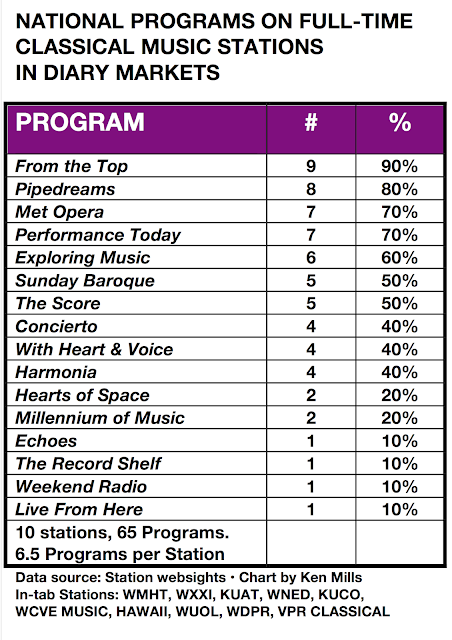You
read it here first!
There
is a big difference between classical music stations in PPM markets and ones in
Diary markets: The Classical stations in PPM markets don't use many nationally syndicated programs.
An
analysis by Spark News of national
program carriage found that Classical music stations in PPM markets are only
airing 2.2 syndicated programs per week. However, Classical music station in
Diary markets air an average of 6.5 programs per week. This is a huge
difference.
Note: Our analysis did not include orchestra or concert broadcasts.
Note: Our analysis did not include orchestra or concert broadcasts.
Why is this happening?
There
are several reasons. Most are products of adio programming philosophies.
The chart on the left shows the carriage of national programs on 24 full-time Classical music stations.
Stations
of all formats in big PPM markets are focused on retaining listeners. This
calls for greater engagement, sort of like “Welcome
to our club.”
Programs
from outside sources “sound different,” and might not support the station brand.
Instead, many Classical music stations in PPM markets are having their hosts
narrate locally produced themed programs in the places on the schedules where
national shows used to be. Network Program marketers must be “having a cow” over the missing major markets.
In many ways, you can truthfully say that the bigger the station/market, the fewer national
programs they air. This isn't a good trend or bad trend, it just is what is
happening now.
We
looked at the schedules for the top 24 full-time Classical music stations in
PPM markets, as determined by their estimated weekly listeners from Fall 2018.
Then
we looked at the top 10 full-time Classical music stations in Diary markets,
also ranked by their estimated weekly listeners from Fall 2018.
As
you can see in the next chart, there is a profound difference between the PPM and
Diary market stations regarding their use of national programs.
There
are several shows that perform well no matter what the market size is.
From the Top, Pipedreams and the mighty Met Opera succeed because they are highly focused on ne thing.
Look at how different carriage is for WFMT’s Exploring
Music with Bill McLaughlin. It is a hit in smaller markets but doesn’t even
cast a shadow in PPM markets.
The same pattern is seen with Performance Today.
Stations in Diary markets like PT's quality and utility
value. Not so much on the PPM stations,
Why
is this important? It is because it is
so different than other public radio formats.
The
public radio system was built on the universal carriage of All Things
Considered and Morning Edition. These two NPR shows created the national
“heartbeat” of NPR. They are the essence of the brand.
Last
Friday we saw that WXPN’s World Cafe embodies the essence of the AAA format.
A
majority (61%) of AAA stations carry the program,
However,
there is not even one Classical music national program that even
gets half of the stations in PPM markets to carry the program.
But, in Diary markets many national
programs have near universal carriage.




It's really quite simple: larger market, larger budget (in general). Stations that are resource-rich have the ability to worry about things like maintaining a brand across dayparts, whereas smaller stations in smaller markets might have only a few full-time people at the most, and national programs are the only way they can fill air time.
ReplyDeleteVery interesting. We, as a minor syndicator, have noticed the down trend in interest in syndicated programming. However, how come you didn't include orchestra broadcasts? Or didn't any show up?
ReplyDeleteRobert Conrad, WCLV, Cleveland